Pentax K-30 vs K-5
The Pentax K-30 and the Pentax K-5 are two digital cameras that were officially introduced, respectively, in May 2012 and September 2010. Both are DSLR (Digital Single Lens Reflex) cameras that are equipped with an APS-C sensor. Both cameras offer a resolution of 16.1 megapixels.
Below is an overview of the main specs of the two cameras as a starting point for the comparison.

Check K-30 offers at
ebay.com

Check K-5 offers at
ebay.com
Going beyond this snapshot of core features and characteristics, what are the differences between the Pentax K-30 and the Pentax K-5? Which one should you buy? Read on to find out how these two cameras compare with respect to their body size, their imaging sensors, their shooting features, their input-output connections, and their reception by expert reviewers.
Body comparison
An illustration of the physical size and weight of the Pentax K-30 and the Pentax K-5 is provided in the side-by-side display below. The two cameras are presented according to their relative size. Three consecutive perspectives from the front, the top, and the back are available. All size dimensions are rounded to the nearest millimeter.
The K-30 can be obtained in seven different colors (black, silver, blue, red, yellow, green, white), while the K-5 is only available in black.
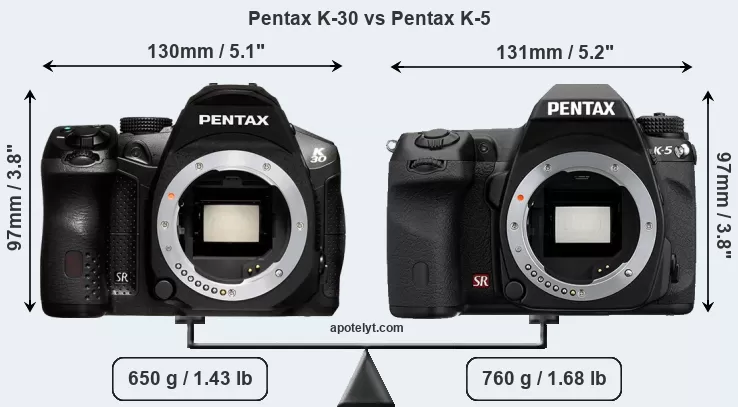
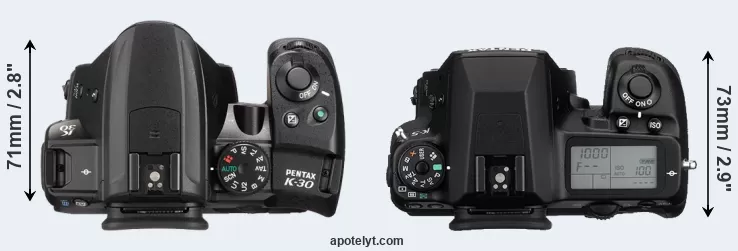
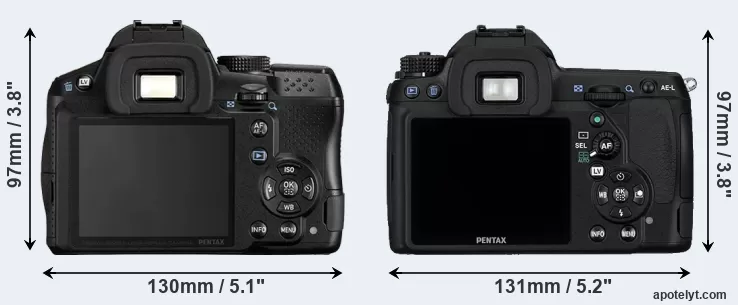
If the front view area (width x height) of the cameras is taken as an aggregate measure of their size, the Pentax K-30 and the Pentax K-5 are of equal size. However, the K-5 is markedly heavier (17 percent) than the K-30. In this context, it is worth noting that both cameras are splash and dust-proof and can, hence, be used in inclement weather conditions or harsh environments.
The above size and weight comparisons are to some extent incomplete since they do not consider the interchangeable lenses that both of these cameras require. Hence, you might want to study and compare the specifications of available lenses in order to get the full picture of the size and weight of the two camera systems.
Concerning battery life, the K-30 gets 410 shots out of its Pentax D-LI109 battery, while the K-5 can take 740 images on a single charge of its Pentax D-LI90 power pack.
The adjacent table lists the principal physical characteristics of the two cameras alongside a wider set of alternatives. If you would like to visualize and compare a different camera combination, you can navigate to the CAM-parator app and make your selection from a broad list of cameras there.

| Camera Model |
Camera Width |
Camera Height |
Camera Depth |
Camera Weight |
Battery Life |
Weather Sealing |
Camera Launch |
Launch Price (USD) |
Street Price |
||
|---|---|---|---|---|---|---|---|---|---|---|---|
| 1. | Pentax K-30 | 130 mm | 97 mm | 71 mm | 650 g | 410 | Y | May 2012 | 849 | ebay.com | |
| 2. | Pentax K-5 | 131 mm | 97 mm | 73 mm | 760 g | 740 | Y | Sep 2010 | 1,099 | ebay.com | |
| 3. | Pentax K-3 | 131 mm | 100 mm | 77 mm | 800 g | 560 | Y | Oct 2013 | 1,299 | ebay.com | |
| 4. | Pentax K-3 II | 131 mm | 100 mm | 77 mm | 800 g | 720 | Y | Apr 2015 | 1,099 | ebay.com | |
| 5. | Pentax K-5 II | 131 mm | 97 mm | 73 mm | 760 g | 740 | Y | Sep 2012 | 1,099 | ebay.com | |
| 6. | Pentax K-50 | 130 mm | 97 mm | 71 mm | 650 g | 410 | Y | Jun 2013 | 599 | ebay.com | |
| 7. | Pentax K-500 | 130 mm | 97 mm | 71 mm | 646 g | 710 | n | Jun 2013 | 549 | ebay.com | |
| 8. | Pentax KP | 132 mm | 101 mm | 76 mm | 703 g | 390 | Y | Jan 2017 | 1,099 | ebay.com | |
| 9. | Pentax K-S1 | 121 mm | 93 mm | 70 mm | 558 g | 410 | n | Aug 2014 | 749 | ebay.com | |
| 10. | Pentax K-S2 | 123 mm | 91 mm | 73 mm | 678 g | 410 | Y | Feb 2015 | 749 | ebay.com | |
| 11. | Sony A77 | 143 mm | 104 mm | 81 mm | 732 g | 470 | Y | Aug 2011 | 1,399 | ebay.com | |
| Note: Measurements and pricing do not include easily detachable parts, such as add-on or interchangeable lenses or optional viewfinders. | |||||||||||
Any camera decision will obviously take relative prices into account. The listed launch prices provide an indication of the market segment that the manufacturer of the cameras have been targeting. The K-30 was launched at a somewhat lower price (by 23 percent) than the K-5, which makes it more attractive for photographers on a tight budget. Usually, retail prices stay at first close to the launch price, but after several months, discounts become available. Later in the product cycle and, in particular, when the replacement model is about to appear, further discounting and stock clearance sales often push the camera price considerably down. Then, after the new model is out, very good deals can frequently be found on the pre-owned market.
Sensor comparison
The size of the sensor inside a digital camera is one of the key determinants of image quality. A large sensor will generally have larger individual pixels that offer better low-light sensitivity, provide wider dynamic range, and have richer color-depth than smaller pixels in a sensor of the same technological generation. Further, a large sensor camera will give the photographer additional creative options when using shallow depth-of-field to isolate a subject from its background. On the downside, larger sensors tend to be associated with larger, more expensive camera bodies and lenses.
Both cameras under consideration feature an APS-C sensor, but their sensors differ slightly in size. The sensor area in the K-5 is 1 percent bigger. They nevertheless have the same format factor of 1.5. Both cameras have a native aspect ratio (sensor width to sensor height) of 3:2.
Technology-wise, the K-5 uses a more advanced image processing engine (PRIME II) than the K-30 (PRIME M), with benefits for noise reduction, color accuracy, and processing speed.
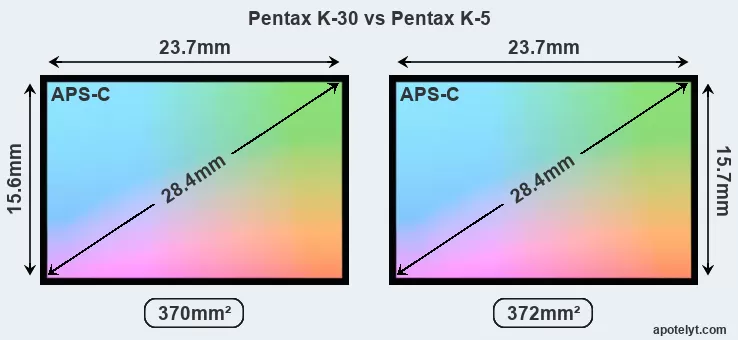
Even though the K-5 has a slightly larger sensor, both cameras offer the same resolution of 16.1 megapixels. This implies that the K-5 has a lower pixel density and marginally larger individual pixels (with a pixel pitch of 4.81μm versus 4.79μm for the K-30), which gives it a potential advantage in terms of light gathering capacity. It should, however, be noted that the K-30 is a somewhat more recent model (by 1 year and 8 months) than the K-5, and its sensor might have benefitted from technological advances during this time that at least partly compensate for the smaller pixel size.
The Pentax K-30 has a native sensitivity range from ISO 100 to ISO 12800, which can be extended to ISO 100-25600. The corresponding ISO settings for the Pentax K-5 are ISO 100 to ISO 12800, with the possibility to increase the ISO range to 80-51200.
Technology-wise, both cameras are equipped with CMOS (Complementary Metal–Oxide–Semiconductor) sensors. Both cameras use a Bayer filter for capturing RGB colors on a square grid of photosensors. This arrangement is found in most digital cameras.
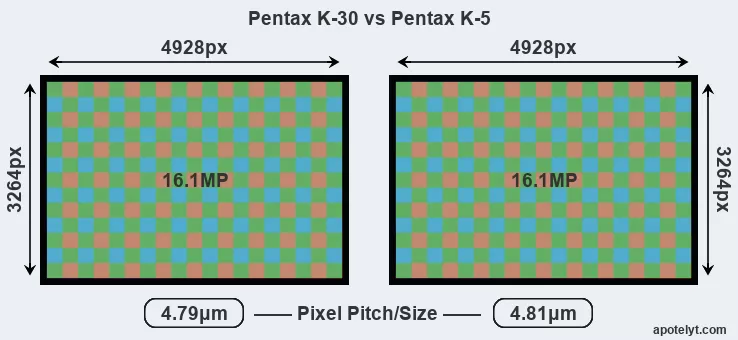
Since 2007, DXO Mark has published sensor performance measurements that have been derived using a consistent methodology. This service assesses and scores the color depth ("DXO Portrait"), dynamic range ("DXO Landscape"), and low-light sensitivity ("DXO Sports") of camera sensors, and also publishes an overall camera score. The Overall DXO ratings for the two cameras under consideration are close, suggesting that they provide similar imaging performance. The adjacent table reports on the physical sensor characteristics and the outcomes of the DXO sensor quality tests for a sample of comparator-cameras.

| Camera Model |
Sensor Class |
Resolution (MP) |
Horiz. Pixels |
Vert. Pixels |
Video Format |
DXO Portrait |
DXO Landscape |
DXO Sports |
DXO Overall |
||
|---|---|---|---|---|---|---|---|---|---|---|---|
| 1. | Pentax K-30 | APS-C | 16.1 | 4928 | 3264 | 1080/30p | 23.7 | 13.0 | 1129 | 79 | |
| 2. | Pentax K-5 | APS-C | 16.1 | 4928 | 3264 | 1080/25p | 23.7 | 14.1 | 1162 | 82 | |
| 3. | Pentax K-3 | APS-C | 24.1 | 6016 | 4000 | 1080/60i | 23.7 | 13.4 | 1216 | 80 | |
| 4. | Pentax K-3 II | APS-C | 24.1 | 6016 | 4000 | 1080/60i | 23.6 | 13.6 | 1106 | 80 | |
| 5. | Pentax K-5 II | APS-C | 16.1 | 4928 | 3264 | 1080/25p | 23.8 | 14.1 | 1235 | 82 | |
| 6. | Pentax K-50 | APS-C | 16.1 | 4928 | 3264 | 1080/30p | 23.7 | 13.0 | 1120 | 79 | |
| 7. | Pentax K-500 | APS-C | 16.1 | 4928 | 3264 | 1080/30p | 23.7 | 13.1 | 1087 | 79 | |
| 8. | Pentax KP | APS-C | 24.1 | 6016 | 4000 | 1080/60i | 23.9 | 13.2 | 1699 | 81 | |
| 9. | Pentax K-S1 | APS-C | 20.0 | 5472 | 3648 | 1080/30p | 23.5 | 13.0 | 1061 | 78 | |
| 10. | Pentax K-S2 | APS-C | 20.0 | 5472 | 3648 | 1080/30p | 23.6 | 12.9 | 1514 | 79 | |
| 11. | Sony A77 | APS-C | 24.0 | 6000 | 4000 | 1080/60p | 24.0 | 13.2 | 801 | 78 | |
| Note: DXO values in italics represent estimates based on sensor size and age. | |||||||||||
Many modern cameras cannot only take still pictures, but also record videos. Both cameras under consideration have a sensor with sufficiently fast read-out times for moving pictures, but the K-30 provides a higher frame rate than the K-5. It can shoot video footage at 1080/30p, while the K-5 is limited to 1080/25p.
Feature comparison
Beyond body and sensor, cameras can and do differ across a range of features. The K-30 and the K-5 are similar in the sense that both have an optical viewfinder. The latter is useful for getting a clear image for framing even in brightly lit environments. The viewfinders of both cameras offer the same field of view (100%), as well as the same magnification (0.61x). The table below summarizes some of the other core capabilities of the Pentax K-30 and Pentax K-5 in connection with corresponding information for a sample of similar cameras.

| Camera Model |
Viewfinder (Type or 000 dots) |
Control Panel (yes/no) |
LCD Specifications (inch/000 dots) |
LCD Attach- ment |
Touch Screen (yes/no) |
Max Shutter Speed * |
Max Shutter Flaps * |
Built-in Flash (yes/no) |
Built-in Image Stab |
||
|---|---|---|---|---|---|---|---|---|---|---|---|
| 1. | Pentax K-30 | optical | n | 3.0 / 921 | fixed | n | 1/6000s | 6.0/s | Y | Y | |
| 2. | Pentax K-5 | optical | Y | 3.0 / 921 | fixed | n | 1/8000s | 7.0/s | Y | Y | |
| 3. | Pentax K-3 | optical | Y | 3.2 / 1037 | fixed | n | 1/8000s | 8.3/s | Y | Y | |
| 4. | Pentax K-3 II | optical | Y | 3.2 / 1037 | fixed | n | 1/8000s | 8.3/s | n | Y | |
| 5. | Pentax K-5 II | optical | Y | 3.0 / 921 | fixed | n | 1/8000s | 7.0/s | Y | Y | |
| 6. | Pentax K-50 | optical | n | 3.0 / 921 | fixed | n | 1/6000s | 6.0/s | Y | Y | |
| 7. | Pentax K-500 | optical | n | 3.0 / 921 | fixed | n | 1/6000s | 6.0/s | Y | Y | |
| 8. | Pentax KP | optical | n | 3.0 / 921 | tilting | n | 1/6000s | 7.0/s | Y | Y | |
| 9. | Pentax K-S1 | optical | n | 3.0 / 921 | fixed | n | 1/6000s | 5.4/s | Y | Y | |
| 10. | Pentax K-S2 | optical | n | 3.0 / 921 | swivel | n | 1/6000s | 5.4/s | Y | Y | |
| 11. | Sony A77 | 2359 | Y | 3.0 / 921 | full-flex | n | 1/8000s | 12.0/s | Y | Y | |
| Note: *) Information refers to the mechanical shutter, unless the camera only has an electronic one. | |||||||||||
One feature that is present on the K-5, but is missing on the K-30 is a top-level LCD. While being, of course, smaller than the rear screen, the control panel conveys some of the essential shooting information and can be convenient for quick and easy settings verification.
The Pentax K-5 has an intervalometer built-in. This enables the photographer to capture time lapse sequences, such as flower blooming, a sunset or moon rise, without purchasing an external camera trigger and related software.
Concerning the storage of imaging data, both the K-30 and the K-5 write their files to SDXC cards.
Connectivity comparison
For some imaging applications, the extent to which a camera can communicate with its environment can be an important aspect in the camera decision process. The table below provides an overview of the connectivity of the Pentax K-30 and Pentax K-5 and, in particular, the interfaces the cameras (and selected comparators) provide for accessory control and data transfer.

| Camera Model |
Hotshoe Port |
Internal Mic / Speaker |
Microphone Port |
Headphone Port |
HDMI Port |
USB Port |
WiFi Support |
NFC Support |
Bluetooth Support |
||
|---|---|---|---|---|---|---|---|---|---|---|---|
| 1. | Pentax K-30 | Y | mono / mono | - | - | - | 2.0 | - | - | - | |
| 2. | Pentax K-5 | Y | stereo / mono | Y | - | mini | 2.0 | - | - | - | |
| 3. | Pentax K-3 | Y | mono / mono | Y | Y | mini | 3.0 | - | - | - | |
| 4. | Pentax K-3 II | Y | mono / mono | Y | Y | mini | 3.0 | - | - | - | |
| 5. | Pentax K-5 II | Y | stereo / mono | Y | - | mini | 2.0 | - | - | - | |
| 6. | Pentax K-50 | Y | mono / mono | - | - | micro | 2.0 | - | - | - | |
| 7. | Pentax K-500 | Y | mono / mono | - | - | - | 2.0 | - | - | - | |
| 8. | Pentax KP | Y | stereo / mono | Y | - | - | 2.0 | Y | - | - | |
| 9. | Pentax K-S1 | Y | stereo / mono | - | - | micro | 2.0 | - | - | - | |
| 10. | Pentax K-S2 | Y | mono / mono | Y | - | micro | 2.0 | Y | Y | - | |
| 11. | Sony A77 | Y | stereo / mono | Y | - | mini | 2.0 | - | - | - |
It is notable that the K-5 has a microphone port, which can help to improve the quality of audio recordings by attaching an external microphone. The K-30 does not feature such a mic input.
Studio photographers will appreciate that the Pentax K-5 (unlike the K-30) features a PC Sync socket, so that professional strobe lights can be controlled by the camera.
Both the K-30 and the K-5 have been discontinued, but can regularly be found used on ebay. The K-5 was replaced by the Pentax K-5 II, while the K-30 was followed by the Pentax K-50. Further information on the features and operation of the K-30 and K-5 can be found, respectively, in the Pentax K-30 Manual (free pdf) or the online Pentax K-5 Manual.
Review summary
So what conclusions can be drawn? Which of the two cameras – the Pentax K-30 or the Pentax K-5 – has the upper hand? Is one clearly better than the other? The listing below highlights the relative strengths of the two models.
Reasons to prefer the Pentax K-30:
- Better video: Provides higher movie framerates (1080/30p versus 1080/25p).
- Less heavy: Is lighter (by 110g or 14 percent) and hence easier to carry around.
- More affordable: Was introduced into a lower priced segment (23 percent cheaper at launch).
- More modern: Is somewhat more recent (announced 1 year and 8 months after the K-5).
Advantages of the Pentax K-5:
- More dynamic range: Captures a broader range of light and dark details (1.1 EV of extra DR).
- Better jpgs: Has a more modern image processing engine (PRIME II vs PRIME M).
- Better sound: Can connect to an external microphone for higher quality sound recording.
- Easier setting verification: Features a control panel on top to check shooting parameters.
- Faster shutter: Has higher mechanical shutter speed (1/8000s vs 1/6000s) to freeze action.
- Faster burst: Shoots at higher frequency (7 vs 6 flaps/sec) to capture the decisive moment.
- Easier time-lapse photography: Has an intervalometer built-in for low frequency shooting.
- Longer lasting: Gets more shots (740 versus 410) out of a single battery charge.
- Better studio light control: Has a PC Sync socket to connect to professional strobe lights.
- More heavily discounted: Has been on the market for longer (launched in September 2010).
If the count of individual advantages (bullet points above) is taken as a guide, the K-5 is the clear winner of the contest (10 : 4 points). However, the pertinence of the various camera strengths will differ across photographers, so that you might want to weigh individual camera traits according to their importance for your own imaging needs before making a camera decision. A professional wildlife photographer will view the differences between cameras in a way that diverges from the perspective of a family photog, and a person interested in architecture has distinct needs from a sports shooter. Hence, the decision which camera is best and worth buying is often a very personal one.
How about other alternatives? Do the specifications of the Pentax K-30 and the Pentax K-5 place the cameras among the top in their class? Find out in the latest Best DSLR Camera listing whether the two cameras rank among the cream of the crop.
In any case, while the specs-based evaluation of cameras can be instructive in revealing their potential as photographic tools, it remains incomplete and does no justice, for example, to the way the K-30 or the K-5 perform in practice. At times, user reviews, such as those published at amazon, address these issues in a useful manner, but such feedback is on many occasions incomplete, inconsistent, and unreliable.
Expert reviews
This is why expert reviews are important. The adjacent summary-table relays the overall verdicts of several of the most popular camera review sites (amateurphotographer [AP], cameralabs [CL], digitalcameraworld [DCW], dpreview [DPR], ephotozine [EPZ], photographyblog [PB]). As can be seen, the professional reviewers agree in many cases on the quality of different cameras, but sometimes their assessments diverge, reinforcing the earlier point that a camera decision is often a very personal choice.

| Camera Model |
AP score |
CL score |
DCW score |
DPR score |
EPZ score |
PB score |
Camera Launch |
Launch Price (USD) |
Street Price |
||
|---|---|---|---|---|---|---|---|---|---|---|---|
| 1. | Pentax K-30 | 4/5 | .. | .. | 78/100 | 4.5/5 | 4.5/5 | May 2012 | 849 | ebay.com | |
| 2. | Pentax K-5 | 4/5 | .. | .. | 83/100 | 5/5 | 4.5/5 | Sep 2010 | 1,099 | ebay.com | |
| 3. | Pentax K-3 | 4/5 | .. | .. | 83/100 | 5/5 | 5/5 | Oct 2013 | 1,299 | ebay.com | |
| 4. | Pentax K-3 II | 4.5/5 | .. | .. | .. | 5/5 | 5/5 | Apr 2015 | 1,099 | ebay.com | |
| 5. | Pentax K-5 II | 5/5 | .. | .. | 80/100 | 5/5 | 4.5/5 | Sep 2012 | 1,099 | ebay.com | |
| 6. | Pentax K-50 | 5/5 | .. | .. | .. | 5/5 | 4.5/5 | Jun 2013 | 599 | ebay.com | |
| 7. | Pentax K-500 | .. | .. | .. | .. | 4.5/5 | 4.5/5 | Jun 2013 | 549 | ebay.com | |
| 8. | Pentax KP | 4/5 | .. | 3/5 | 82/100 | 5/5 | 4.5/5 | Jan 2017 | 1,099 | ebay.com | |
| 9. | Pentax K-S1 | 4/5 | .. | .. | .. | 4.5/5 | 4/5 | Aug 2014 | 749 | ebay.com | |
| 10. | Pentax K-S2 | 4.5/5 | .. | .. | .. | 5/5 | 4.5/5 | Feb 2015 | 749 | ebay.com | |
| 11. | Sony A77 | 5/5 | 91/100 | .. | 81/100 | .. | 5/5 | Aug 2011 | 1,399 | ebay.com | |
| Note: (+ +) highly recommended; (+) recommended; (o) reviewed; (..) not available. | |||||||||||
The review scores listed above should be treated with care, though. The ratings were established in reference to similarly priced cameras that were available in the market at the time of the review. A score, therefore, has to be seen in close connection to the price and market introduction time of the camera, and comparing ratings of very distinct cameras or ones that are far apart in terms of their release date have little meaning. It should also be noted that some of the review sites have over time altered the way they render their verdicts.

Check K-30 offers at
ebay.com

Check K-5 offers at
ebay.com
Other camera comparisons
Did this review help to inform your camera decision process? In case you would like to check on the differences and similarities of other camera models, just make your choice using the following search menu. There is also a set of direct links to comparison reviews that other users of the CAM-parator app explored.
- Canon 77D vs Pentax K-30
- Canon T5i vs Pentax K-30
- Fujifilm GFX 100S vs Pentax K-30
- Fujifilm X-S10 vs Pentax K-30
- Fujifilm XQ1 vs Pentax K-5
- Nikon D5300 vs Pentax K-5
- Nikon Z6 II vs Pentax K-5
- Panasonic FZ1000 II vs Pentax K-30
- Panasonic S5 vs Pentax K-5
- Pentax K-30 vs Sony A7R III
- Pentax K-5 vs Ricoh WG-6
- Pentax K-5 vs Sony A6300
Specifications: Pentax K-30 vs Pentax K-5
Below is a side-by-side comparison of the specs of the two cameras to facilitate a quick review of their differences and common features.
| Camera Model | Pentax K-30 | Pentax K-5 |
|---|---|---|
| Camera Type | Digital single lens reflex | Digital single lens reflex |
| Camera Lens | Pentax K mount lenses | Pentax K mount lenses |
| Launch Date | May 2012 | September 2010 |
| Launch Price | USD 849 | USD 1,099 |
| Sensor Specs | Pentax K-30 | Pentax K-5 |
| Sensor Technology | CMOS | CMOS |
| Sensor Format | APS-C Sensor | APS-C Sensor |
| Sensor Size | 23.7 x 15.6 mm | 23.7 x 15.7 mm |
| Sensor Area | 369.72 mm2 | 372.09 mm2 |
| Sensor Diagonal | 28.4 mm | 28.4 mm |
| Crop Factor | 1.5x | 1.5x |
| Sensor Resolution | 16.1 Megapixels | 16.1 Megapixels |
| Image Resolution | 4928 x 3264 pixels | 4928 x 3264 pixels |
| Pixel Pitch | 4.79 μm | 4.81 μm |
| Pixel Density | 4.35 MP/cm2 | 4.32 MP/cm2 |
| Moiré control | Anti-Alias filter | Anti-Alias filter |
| Movie Capability | 1080/30p Video | 1080/25p Video |
| ISO Setting | 100 - 12,800 ISO | 100 - 12,800 ISO |
| ISO Boost | 100 - 25,600 ISO | 80 - 51,200 ISO |
| Image Processor | PRIME M | PRIME II |
| DXO Sensor Quality (score) | 79 | 82 |
| DXO Color Depth (bits) | 23.7 | 23.7 |
| DXO Dynamic Range (EV) | 13.0 | 14.1 |
| DXO Low Light (ISO) | 1129 | 1162 |
| Screen Specs | Pentax K-30 | Pentax K-5 |
| Viewfinder Type | Optical viewfinder | Optical viewfinder |
| Viewfinder Field of View | 100% | 100% |
| Viewfinder Magnification | 0.61x | 0.61x |
| Top-Level Screen | no Top Display | Control Panel |
| LCD Framing | Live View | Live View |
| Rear LCD Size | 3.0inch | 3.0inch |
| LCD Resolution | 921k dots | 921k dots |
| LCD Attachment | Fixed screen | Fixed screen |
| Shooting Specs | Pentax K-30 | Pentax K-5 |
| Focus System | Phase-detect AF | Phase-detect AF |
| Manual Focusing Aid | Focus Peaking | no Peaking Feature |
| Continuous Shooting | 6 shutter flaps/s | 7 shutter flaps/s |
| Time-Lapse Photography | no Intervalometer | Intervalometer built-in |
| Image Stabilization | In-body stabilization | In-body stabilization |
| Fill Flash | Built-in Flash | Built-in Flash |
| Storage Medium | SDXC cards | SDXC cards |
| Single or Dual Card Slots | Single card slot | Single card slot |
| UHS card support | no | no |
| Connectivity Specs | Pentax K-30 | Pentax K-5 |
| External Flash | Hotshoe | Hotshoe |
| Studio Flash | no PC Sync | PC Sync socket |
| USB Connector | USB 2.0 | USB 2.0 |
| HDMI Port | no HDMI | mini HDMI |
| Microphone Port | no MIC socket | External MIC port |
| Wifi Support | no Wifi | no Wifi |
| Body Specs | Pentax K-30 | Pentax K-5 |
| Environmental Sealing | Weathersealed body | Weathersealed body |
| Battery Type | Pentax D-LI109 | Pentax D-LI90 |
| Battery Life (CIPA) | 410 shots per charge | 740 shots per charge |
| Body Dimensions |
130 x 97 x 71 mm (5.1 x 3.8 x 2.8 in) |
131 x 97 x 73 mm (5.2 x 3.8 x 2.9 in) |
| Camera Weight | 650 g (22.9 oz) | 760 g (26.8 oz) |

Check K-30 offers at
ebay.com

Check K-5 offers at
ebay.com
Did you notice an error on this page? If so, please get in touch, so that we can correct the information.

